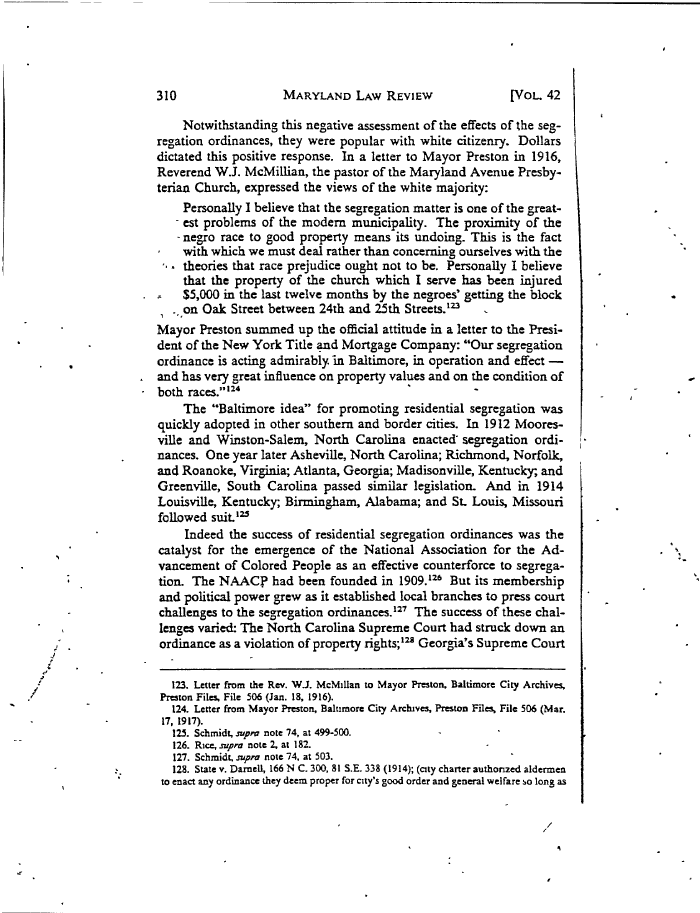 |
||||
|
Garrett Power, Apartheid Baltimore Style: The Residential Segregation Ordinances of 1910-1913, Maryland Law Review, 42 (1983) , Image No: 23 Enlarge and print image (59K) << PREVIOUS NEXT >> |
 |
||||
|
Garrett Power, Apartheid Baltimore Style: The Residential Segregation Ordinances of 1910-1913, Maryland Law Review, 42 (1983) , Image No: 23 Enlarge and print image (59K) << PREVIOUS NEXT >> |
| 310 MARYLAND LAW REVIEW [You 42 Notwithstanding this negative assessment of the effects of the seg- regation ordinances, they were popular with white citizenry. Dollars dictated this positive response. In a letter to Mayor Preston in 1916, Reverend W. J. McMillian, the pastor of the Maryland Avenue Presby- terian Church, expressed the views of the white majority: Personally I believe that the segregation matter is one of the great- est problems of the modern municipality. The proximity of the - negro race to good property means its undoing. This is the fact with which we must deal rather than concerning ourselves with the theories that race prejudice ought not to be. Personally I believe that the property of the church which I serve has been injured $5,000 in the last twelve months by the negroes' getting the block ..on Oak Street between 24th and 25th Streets.123 Mayor Preston summed up the official attitude in a letter to the Presi- dent of the New York Title and Mortgage Company: "Our segregation ordinance is acting admirably, in Baltimore, in operation and effect — and has very great influence on property values and on the condition of both races.124 The "Baltimore idea" for promoting residential segregation was quickly adopted in other southern and border cities. In 1912 Moores- ville and Winston-Salem, North Carolina enacted segregation ordi- nances. One year later Asheville, North Carolina; Richmond, Norfolk, and Roanoke, Virginia; Atlanta, Georgia; Madisonville, Kentucky; and Greenville, South Carolina passed similar legislation. And in 1914 Louisville, Kentucky; Birmingham, Alabama; and St. Louis, Missouri followed suit123 Indeed the success of residential segregation ordinances was the catalyst for the emergence of the National Association for the Ad- vancement of Colored People as an effective counterforce to segrega- tion. The NAACP had been founded in 1909.126 But its membership and political power grew as it established local branches to press court challenges to the segregation ordinances.127 The success of these chal- lenges varied: The North Carolina Supreme Court had struck down an ordinance as a violation of property rights;128 Georgia's Supreme Court 123. Letter from the Rev. WJ. McMillan to Mayor Preston. Baltimore City Archives, Preston Files, File 506 (Jan. 18, 1916). 124. Letter from Mayor Preston, Baltimore City Archives, Preston Files, File 506 (Mar. 17, 1917). 125. Schmidt, supra note 74, at 499-500. 126. Rice, supra note 2, at 182. 127. Schmidt, supra note 74, at 503. 128. State v. Damell, 166 N C. 300, 81 S.E. 338 (1914); (city charter authorized aldermen to enact any ordinance they deem proper for city's good order and general welfare so long as |